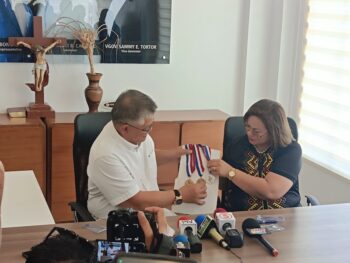 Scenes like this one at Bankerohan Market in Davao City on Dec. 24, 2021 are blamed for the current surge in COVID-19. Mindanews file photo
Scenes like this one at Bankerohan Market in Davao City on Dec. 24, 2021 are blamed for the current surge in COVID-19. Mindanews file photo
DAVAO CITY (MindaNews / 04 February) – Ninety-three or 67% of the 138 samples from Davao Region that were sent for whole genome sequencing at the University of the Philippines-Philippine Genome Center in Manila last January 13 turned out positive for the Omicron variant of COVID-19, the Department of Health (DOH)-Davao reported on Friday.
Dr. Rachel Joy Pasion, head of the Regional Epidemiology and Surveillance Unit of DOH-Davao, said during a virtual press conference on Friday that the region now has a total of 111 cases of this variant, of which 96 are local and 15 are returning overseas Filipinos (ROFs).
Of the 111 cases, Pasion said that 74 were fully vaccinated, two had received booster shot, four received only the first dose, 25 were unvaccinated, and six were subject for verification.
She said the variant’s increased resistance to the vaccines explains why many vaccinated individuals have contracted it.
“Health experts say one of the indications that an area may have Omicron already even without the whole genome sequencing are when there are high breakthrough cases and of these cases are asymptomatic and mild,” she said.
Based on the presentation, Pasion reported that 65 local cases and 10 ROFs of this variant came from Davao City, two local from Davao Occidental, four local and one ROF from Davao del Sur, 15 local and three ROF from Davao del Norte, seven local and one ROF from Davao Oriental, and three local from Davao de Oro.
She added that 84 of these cases have already recovered and 27 are still under investigation.
The Delta remains the dominant variant of concern in the region with 530 cases, followed by Beta with 335, and Alpha with 149, according to DOH-Davao.
Pasion said the agency has seen a lower positivity rate, decreasing to 35% from over 50% in the previous weeks.
“We can see a slight decrease in our positivity compared with the surge we had in previous weeks, in January. However, it is not enough so that we can see a decreasing infectivity already or transmission because it has not gone down yet to 5%. We had less than 5% positivity last November and December but come January, it went up to around 50% or more,” she said.
A 5% positivity rate is the threshold considered by the World Health Organization as acceptable.
“It’s still high. Actually, because of the high transmissibility of Omicron, it is still expected that cases may go up. But what we should always take into consideration is the health care utilization because even if cases are high, for as long as they are mild or asymptomatic, they can be isolated at home,” she said,
As of Feb. 3, DOH-Davao reported 908 cases, bringing total cases to 129,612 with12,377 active,113,197 recoveries, and 4,038 deaths.
Of the total cases, 70,074 were reported in Davao City with 5,372 active, 62,853 recoveries, and 1,849 deaths. A total of 9,171 cases were reported in Davao de Oro, 23,510 in Davao del Norte, 13,594 in Davao del Sur, 4,390 in Davao Occidental, and 8,873 in Davao Oriental. (Antonio L. Colina/MindaNews)
